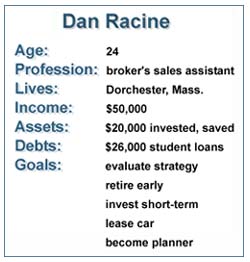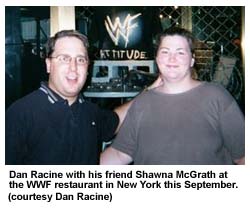|
Going for an early out
|
 |
November 27, 2000: 9:00 a.m. ET
Dan Racine knows what he wants. Can he get there?
By Staff Writer Alex Frew McMillan
|
NEW YORK (CNNfn) - Daniel Racine has always loved money. Growing up with a single mom gave him an interest in interest and an urge to save.
"I didn't come from a healthy financial background, to be sure," he says. His parents divorced when he was 6. His mom worked various jobs, at the grocery store, in day care.
 He remembers things being tight until his mother remarried as he entered his teens. As a result, "I've always been fascinated with money and growing money," he says. He remembers things being tight until his mother remarried as he entered his teens. As a result, "I've always been fascinated with money and growing money," he says.
He figures his finances are decent. But Racine, 24, wants to retire young and travel the world. A few steps now will make a big difference, he believes. Has he made mistakes so far, he wants to know.
Not surprisingly, Racine has picked a financial career. After graduating in 1999, he's worked as a sales assistant for brokerages. He's now with Donaldson, Lufkin & Jenrette in Boston.
Checks & Balances runs weekly. People with questions about financial planning are invited to write in. Click here to go to the Checks & Balances page, with past columns and details on how to submit your information.
"I've always considered myself a bit knowledgeable about the financial-planning process," he says. He thinks he might want to work as a certified financial planner.
Racine is shooting to stop working at 50. He wants to live in Boca Raton, Fla., and he figures he'll need $50,000 to $80,000 a year. So he thinks he needs to save around $2 million.
Should he step up retirement plans?
Right now, he is saving into a Roth IRA. He is also making the maximum contribution to his 401(k) permitted by his company, putting 20 percent of his salary into the Putnam Vista A fund (PVISX) and the Fidelity Blue Chip Growth (FBGRX) fund. He doesn't get a match.
 But now that DLJ has merged with CS First Boston, he'll switch plans Jan. 1. He'll have a dollar-for-dollar match up to $5,000 and be able to pay in 10 percent of his pay pretax. But he could pay in after-tax dollars, too. He wonders if that is a good idea. But now that DLJ has merged with CS First Boston, he'll switch plans Jan. 1. He'll have a dollar-for-dollar match up to $5,000 and be able to pay in 10 percent of his pay pretax. But he could pay in after-tax dollars, too. He wonders if that is a good idea.
Racine plays around with some stocks in his brokerage account. He has around $10,000 there. He thinks having two or three stocks is better than splitting the money between lots of issues.
He hops in and out of Commerce One (CMRC: Research, Estimates) and CMGI (CMGI: Research, Estimates). He just sold his CMGI but is thinking about climbing back in. He likes to look for momentum plays.
"I keep strict selling rules," he explains. "If my stock goes up 20 percent, I will sell, or if it goes down 7 percent to 8 percent I will sell." Because the markets are volatile at the moment, he doesn't like margin.
Paying off loans gradually
Racine grew up in Cape May, N.J. But he moved to Boston to study at Northeastern, in a cooperative program, working half the year. That offset his tuition costs, and he took finance-related internships. He graduated in five years with a business administration degree.
 Racine still lives in the Boston suburb of Dorchester. He figured the cost of living would be less than if he had moved to New York after graduation, another option. Racine splits his $1,480 rent with a friend. Racine still lives in the Boston suburb of Dorchester. He figured the cost of living would be less than if he had moved to New York after graduation, another option. Racine splits his $1,480 rent with a friend.
He also has student loans hanging over him, about $26,000. He pays a little over $200 a month. He would like to pay the loans off quicker but he doesn't want to sacrifice his brokerage and retirement accounts.
"I want to know how I can fully take advantage of the money that I make, being a single guy aged 24," he says. "Am I on the right track?"
What the planners say:
Cal Brown, a certified financial planner with The Monitor Group in Fairfax, Va., likes that Racine is so precise in his ideas.
"Dreams are great," he says. "Specific goals and objectives are even better. Mr. Racine has a clear view of his future, and that is admirable."
But his goals are going to take single-mindedness, the planner opines. For instance, he basically can't get married. If he does, he has to marry someone who is a contributor to rather than a drain on his resources.
That's brutal, Brown admits, but there are lots of choices in life and only so much money. Kids would be out of the question, Brown said. And one more thing – "he must accumulate a TON of money," Brown added.
Click this link to read last week's Checks & Balances column.
Click the following link to read last week's Portfolio Rx, a column that runs every Tuesday in CNNfn's Retirement section. Each article reviews an investor's long-term portfolio, using financial experts to offer advice.
Racine's current policy of saving into his retirement funds conflicts with his idea of retiring early, both Brown and Russell Owen, a certified financial planner with Portland, Ore.-based Strategic Research & Management, note.
He gets a tax break on his 401(k) now. But he won't be able to touch the money until he is 59-1/2. He would get "hammered" with ordinary income tax and penalties if he takes the money out early, Brown points out.
 Owen thinks Racine will be in a higher tax bracket once he needs the money. So he will pay more tax when he withdraws it than he saves now. Owen thinks Racine will be in a higher tax bracket once he needs the money. So he will pay more tax when he withdraws it than he saves now.
Owen says Racine should not pay post-tax dollars into his 401(k). The planner notes he wouldn't be able to roll over post-tax dollars into an IRA if Racine switches employers.
Racine would be better off saving his post-tax income in equities, according to Brown, where he will pay 20 percent capital gains if he holds them long-term – longer than 12 months.
Click here to review your mutual-fund portfolio with CNNfn.com's Morningstar tools.
Click here to go to CNNfn.com's 401 (k) and pension-plan page.
Owen says he is "more than a little confused" by Racine's trading strategy, given the two volatile stocks he has picked. His rules are likely to kick in often, creating trading and tax costs, Owen says. If he really wants to trade, do that in a nontaxable, retirement account, he adds.
Instead, the planner thinks he should build a blue-chip portfolio in his taxable account, with stocks like General Electric (GE: Research, Estimates), which is so big it's almost a mutual fund.
"If you own stocks of this caliber, you will have a much more tax-efficient portfolio," he says. And the tax man will be his biggest enemy as his portfolio grows, Owen notes.
Individual stocks are a gamble and highly volatile, as many investors have discovered this year, Brown says. "Although some investors have been fortunate in recent years to pick the right stocks, most people do not – but you don't hear about them."
Better to decide how much to put in equities, and leave stock picking to the experts or the indexes, Brown believes.
A good estimate, but a tight shave
Brown agrees with Racine's idea to pay off his student loans without sacrificing investing. Because Racine is an aggressive investor, Brown thinks he will likely earn a higher return than the interest on his student loans. "He should continue this strategy," Brown said.
Brown says Racine is pretty close with his estimate that he needs to save around $2 million. Racine will retire on at least $4,000 or so a month. Assuming a 10 percent return on investment and 4 percent inflation, he will need $10,000 a month at retirement age, Brown calculates.
Racine is savings $1,000 a month now, between his 401(k) and his Roth IRA. Brown thinks that should be enough, if his salary and savings also increase 4 percent a year.
But even a small decline in return would derail the plan. At 9 percent return a year, his money would run out at age 67, Brown figures. The planner says he has a 50-50 shot at making his savings plan work.
Brown encourages him not to turn his whole life over to his retirement goal. What if he scrimps and doesn't even live to 50?
"You cannot make a mistake by controlling your spending and maximizing your savings in good equity investments," Brown says. But it would be a mistake to give up on life just to make one goal work.
Brown encourages Racine to stick to the fundamentals: consistent saving, dollar-cost averaging investments, leaving the stock picking to experts, taking as much equity exposure as his timeframe and nerves can afford, and controlling his debt and spending.
* Disclaimer
Got questions about financial planning? Need some advice? Click here for more on CNNfn.com's weekly feature Checks & Balances. 
|
|
|
|
|
 |

|

